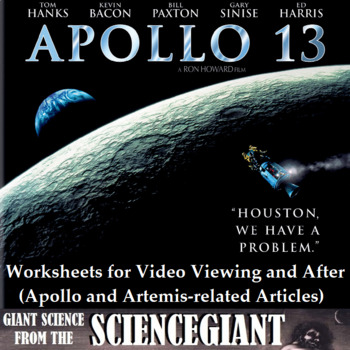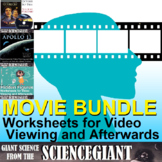Apollo 13 video viewing worksheets and after activities
- PDF
What educators are saying
Also included in
- Teachers use the Strategic Instruction Model (SIM) Concept Enhancement Routines to transform abstract main ideas and key topics into a concrete representation that helps students think about and talk about the key topic and essential related information. SIM is about promoting effective teaching andPrice $49.70Original Price $71.00Save $21.30
- These resources can be used during a unit ( for example, on rocketry and the Space Race), as an emergency substitute activity at any point throughout the school year, or after the completion of state standardized testing (I've done all three). It consists of separate worksheets:Questions that studenPrice $3.85Original Price $5.50Save $1.65
Description
“Houston, we have a problem.” And Ss will have over 50 questions to answer during the video viewing worksheets and after activities with articles on NASA's Artemis.
The film Apollo 13 is a PG-rated adaptation of the true story of a successful failure. Fifty years ago, astronauts Jim Lovell (Hanks), Fred Haise (Paxton) and Jack Swigert (Bacon) are stranded over 200,000 miles from Earth in a crippled spacecraft, fighting a desperate battle to survive. Meanwhile, at Mission Control, a heroic ground crew lead by flight director Gene Kranz (Harris) and astronaut Ken Mattingly (Sinise) race against time - and the odds - to bring them home safely.
This product can be used during a unit on rocketry and the Space Race, as an emergency substitute activity at any point throughout the school year, or after the completion of state standardized testing (I've done all three). It consists of four separate worksheets:
- 30 Questions that students should answer while watching the "Apollo 13". Questions are mostly lower order and focus on the film's plot. They are answered in chronological order of the film's plot for easy completion by students, and encourage student attentiveness. This is followed by a 2 page article How We'll Get Back to the Moon on NASA's Artemis mission for lunar landing in 2024, and reading comprehension related questions.
- Like/Unlike worksheet for after viewing where students can compare and contrast themselves to the characters in the film, and write short answers which can detail their developing intra-personal Intelligence.
- Question cards with Kagan cooperative learning structures fan-n-pick, or quiz-quiz-trade. These cards can be used to start the class conversation, or for comprehension checks in review. And they ensure every student is engaged. Quiz-quiz trade is a model of cooperative learning carried out by two students. Fan-n-pick is used for groups of four or more. Ss are paired, answer questions and exchange explanations using the cards until time has been determined. Directions for included, but there are no "right" answers.
- Penguin Readers Factsheets on the Apollo 13 junior novelization by Dina Anastasio from the motion picture screenplay. Interest level for grades 6-8; lexile level of 570L; 48 pages with 15,207 words and pictures.
This Strategic Instruction was classroom tested to help Ss with the following Florida Next Generation Sunshine State Standard Benchmarks: Students Will Be Able To (SWBAT/I Can)
- SC.8.N.4.1 Explain that science is one of the processes that can be used to inform decision making at the community, state, national, and international levels.
- SC.8.N.4.2 Explain how political, social, and economic concerns can affect science, and vice versa.
- SC.8.E.5.12 Summarize the effects of space exploration on the economy and culture of Florida.
- SC.912.N.2.5 Describe instances in which scientists' varied backgrounds, talents, interests, and goals influence the inferences and thus the explanations that they make about observations of natural phenomena and describe that competing interpretations (explanations) of scientists are a strength of science as they are a source of new, testable ideas that have the potential to add new evidence to support one or another of the explanations.
- SC.912.N.4.1 Explain how scientific knowledge and reasoning provide an empirically-based perspective to inform society's decision making.
- SC.912.N.4.2 Weigh the merits of alternative strategies for solving a specific societal problem by comparing a number of different costs and benefits, such as human, economic, and environmental.
- SC.912.E.5.7 Relate the history of and explain the justification for future space exploration and continuing technology development.
- SC.912.E.5.9 Analyze the broad effects of space exploration on the economy and culture of Florida.
Related Resource
- October Sky video viewing activities
- Hidden Figures video viewing and after activities
- Question Exploration: What Was the Space Race? (Rocket Rivals Russia and USA)
- Question Exploration: How Are Latitude and Longitude Use for Landing Sites?
- Nibble Like a RABBit: Edible Model of a Moon to Mars Tool
- Mission Patch Plan: Design and Meaning for Moon to Mars
- If You Decide To Go To The Moon - ELA Enrichment Activities and Printables
#StayGiant and stay up on my new resources and STEM news. Look for the green ★ star near the top of any page within my store and click "FOLLOW". Or follow @TheScienceGiant Twitter. Stand on The Shoulders of Giants, and together we'll see further, inspire students, and enlighten inquisitive minds!







